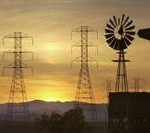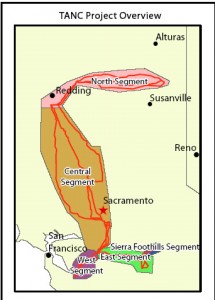
It’s time to tank the TANC project. I love the irony of beautiful shots of transmission lines, particularly where the media is finally getting it right:
“To be sure, it will be ugly.”
Yeah! That’s a direct quote, see the article below…
This 600 mile long and $1.3 billion (somebody better put a new battery in that calculator, that estimate is WAY off) project has wrapped up every ugly aspect of transmission all in one (like almost every other project I’ve seen these days!). Let’s see, yes, it will visually be butt ugly. Landowners didn’t get reasonable notice. It will have massive impact on environment, economics, and public health. Oh, and need we mention, like the others, it’s not needed. Look where it starts and guess how far it is from the nearest coal plants, online or on the drawing board.

Now notice all the back and forths, this isn’t just one line, each segment has at least two, if not three lines (their type gets in the way of ID’ing what’s planned. CLICK HERE FOR THEIR MAP PAGE.
Heard enough? Ready to do something about it?
PRE-MEETING RALLY
HOLIDAY INN — REDDING, CA
Wednesday, July 8, 2009 at 2:00 PM
then
PUBLIC MEETING WITH TANC:
CASCADE THEATRE – MARKET STREET
REDDING, CA
Wednesday, July 8, 2009 at 6:00 PM
ALL LANDOWNERS ATTEND
Need more information:
Here’s the TANC site
*******************************************
From the Modesto Bee:
last updated: June 20, 2009 09:43:13 PM
The word “huge” aptly describes just about everything about the proposed electrical transmission line that would run from northeast California down the Central Valley into the Modesto and Turlock irrigation districts and over to the Bay Area.
The 500-kilovolt line would stretch more than 600 miles, through more than a dozen counties and across thousands of privately-owned properties. The towers would stand up to 150 feet high. And the estimated cost starts at $1.3 billion, but likely will far exceed that.
Size and cost alone make this project controversial, but it has become even hotter because, so far, it has been handled so poorly by the people who want to build it, the Transmission Agency of Northern California. TANC is a joint powers agency comprised of 15 publicly owned utilities, including the MID and TID. The agency’s commission is chaired by MID’s general manager, Allen Short.
Not surprisingly, landowners all the way from Lassen and Shasta to Stanislaus and Tuolumne counties are upset — and angry — at the prospect of a huge transmission line and towers crossing their property.
To be sure, it will be ugly. It will tarnish scenic vistas. It will interfere with farming. And then there are lingering safety concerns about electromagnetic fields.
In addition, many property owners say they were not properly notified of the “scoping” meetings. The uproar is exacerbated by the fact that preliminary maps show multiple routes and swaths 1,000 feet wide, when in fact eventually there would a single route with rights of way of about 200 feet.
It’s not just landowners who are upset; the anger extends to many organizations and elected bodies, including city councils and county supervisors. The chairman of the Yolo County Board of Supervisors spoke bluntly with Capitol Public Radio, saying the project should stop and start all over because Yolo officials were not adequately notified of the plans.
The controversy is so great that TANC hired one of the state’s premier lobbying-public relations firms and a second public relations consultant. TANC also has twice extended the comment period on the scoping maps.
Those were good moves, but they came too late. It will take a lot of work and persuasive arguments to quell the storm — and that will add to the cost of the project.
Short says TANC plans to add a step to the normal process. After reviewing the public comments, it will issue a new alignment; this one will do what the first one should have — for example, avoiding schools and houses.
After the second route map is completed, the formal environmental review process will begin. Only after the EIR is done will the elected boards of the partner utilities make a final decision on whether to proceed. That most likely will be in 2011 or beyond.
Most of the opposition so far has focused on the route and the disruptive impacts of the transmission line. Common questions include, for example, whether all or parts of of the line could be put underground.
But some opponents also challenge the justifications for the project. Basically, there are two:
Renewable: California voters and legislators want more electricity to be produced from renewable resources (solar, wind and geothermal) rather than coal-burning power plants.
Currently, utilities are expected to get 20 percent of their electricity from renewable sources; there’s a push afoot to make it 33 percent.
Short argues that this project provides the best option to achieve the 33 percent. He cites a study showing that a solar panel on every rooftop in Modesto wouldn’t generate enough power to meet the mandated level.
Reliability: The East Coast blackout of 2003 and a much smaller power failure in the MID and TID in summer 2007 are examples of why the districts want to be sure they have multiple transmission lines.
It’s the same reason they are reluctant to put multiple lines on the same towers or the same rights of way. The fear is that one incident — a wildfire, plane crash or even a terrorist act — could black out a whole area.
While these are both important considerations, we believe there are a number of major questions that need to be answered before the MID or TID commit to this huge project:
Building the transmission line presumes that other utilities or private enterprises will then build the solar and wind farms to produce the power that will move across the line. Is that a good presumption given that the Lassen area ranks fairly low as a competitive renewable energy zone, according to a study by the state Renewable Energy Transmission Initiative?
By the time this line is built, will solar technology have advanced to the point that it will make more sense to install panels locally and avoid the transmission cost?
A controversial segment of the line, from New Melones to Riverbank, is proposed by the federal Western Area Power Administration to move hydropower. Is it truly needed?
The MID already carries substantial debt for its other projects — and electricity customers are feeling that with rising rates. Is this project too much of an added burden?
If this transmission line isn’t built — and even if it is — Short argues that someone else will build one, so better it be a public utility such as MID. That, of course, assumes that public ownership is always less expensive. Given the fact that MID residential customers now pay as much for electricity as many PG&E customers, is this assumption still valid?
The MID and TID have strong reputations, and over the years their leaders have shown great foresight in making sure that the future water and power needs of their customers could and would be met.
At this point, the transmission line project requires much more study — and much more sensitivity to the property owners who would be most directly affected. Many of them, in Escalon and Oakdale, for example, are outside the irrigation districts and won’t benefit from the electricity. But they’ll have to live or work around an unsightly tower or transmission line.
Before the boards make their final decisions, they and the public need to be absolutely certain that the transmission line is needed, that it is environmentally sound, and that it is a wise investment for the future.


Leave a Reply